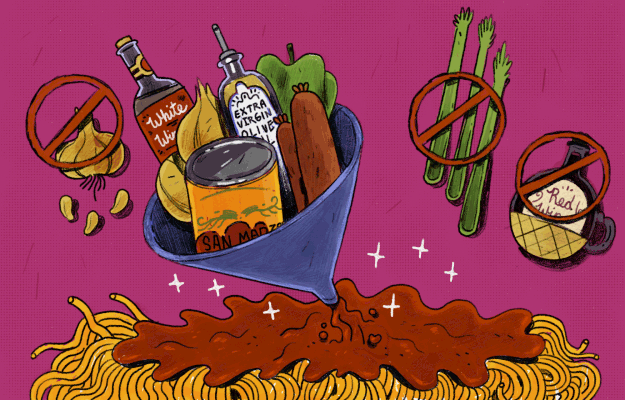
The long road from Schilling Spaghetti Sauce spice mix to simple, herbless perfection.
This is a story that starts around 1967, the second year I was married and trying to learn to cook. I was 20. I decided to make spaghetti sauce. Cheap, filling, lasts the week—those were my requirements back then. I had a model, my mother’s spaghetti sauce, but that was a reverse role model, the kind of sauce I wanted to avoid. Marjorie’s sauce involved onions, garlic, too much celery, the cheapest ground beef available, too much cheap olive oil, jug red wine, tomatoes—not particularly cut up—and an unfortunate choice of herb: rosemary. I didn’t like the taste or texture of rosemary, but it was never an issue while I was living at home. I ate everything that my frugal, widowed mother cooked. She was feeding five boys on a Catholic schoolteacher’s salary; she didn’t raise any fussy eaters.
My own first efforts weren’t much of an improvement. I bought a packet of Schilling Spaghetti Sauce spice mix (the same 1.37-ounce mix is still sold today by McCormick) and followed the package directions. Stir Sauce Mix, water (1¾ cups), 1 can tomato paste (6 ounces) and 1 tablespoon oil (unspecified) in medium saucepan until well blended. Simmer ten minutes. Serve over pasta. Sprinkle with grated parmesan cheese, if desired. I added fried, crumbled ground beef, of course. It wasn’t as bad as my mom’s, but it was essentially bland herbed ketchup without the tang. A chicken cacciatore recipe from The Joy of Cooking was helpful: That recipe started by sautéing fresh onion and bell pepper, then added white wine to tomato paste—all techniques and ingredients I use in my sauce today. But it was a small, delightful book, Pasta by Evelyn Gendel, published in 1966, that started me on the Appian Way.
The book was filled with good, and in that era, rare advice. Spaghetti should be cooked al dente; it should not be broken into pieces; it should be served in bowls, not plates, accompanied by wine, not beer. And most importantly, when draining spaghetti after cooking, do not rinse, as most of North America did. “Nobody but raccoons rinse food before eating,” Evelyn said, and I quoted her with delight. Evelyn talked about the whys, not just the hows. She was opinionated and funny. I started with her tomato sauces and worked my way forward to the meat sauces. I understood, after trying her sausage sauce, that what I didn’t like about most spaghetti sauces was ground beef.
Over the next 20 years I refined my basic sauce. It was a process of elimination, and by elimination, I mean I got rid of some cherished ingredients. I cannot remember when I cut out garlic, but for someone who regularly doubles the amount of garlic in any recipe, it was a watershed day. I switched from red wine to white, cut out butter, put back butter, finally settled on a light, fruity extra-virgin olive oil, learned about San Marzano tomatoes, and tried then eliminated oregano, thyme, marjoram, and sage. What I ended up with, around 1997, is a sauce that while long simmered seems fresh. The flavors are bright and clean, and while it is a rich sauce, it doesn’t seem heavy. It may be more American than Italian, but my customers—family and friends—don’t complain.